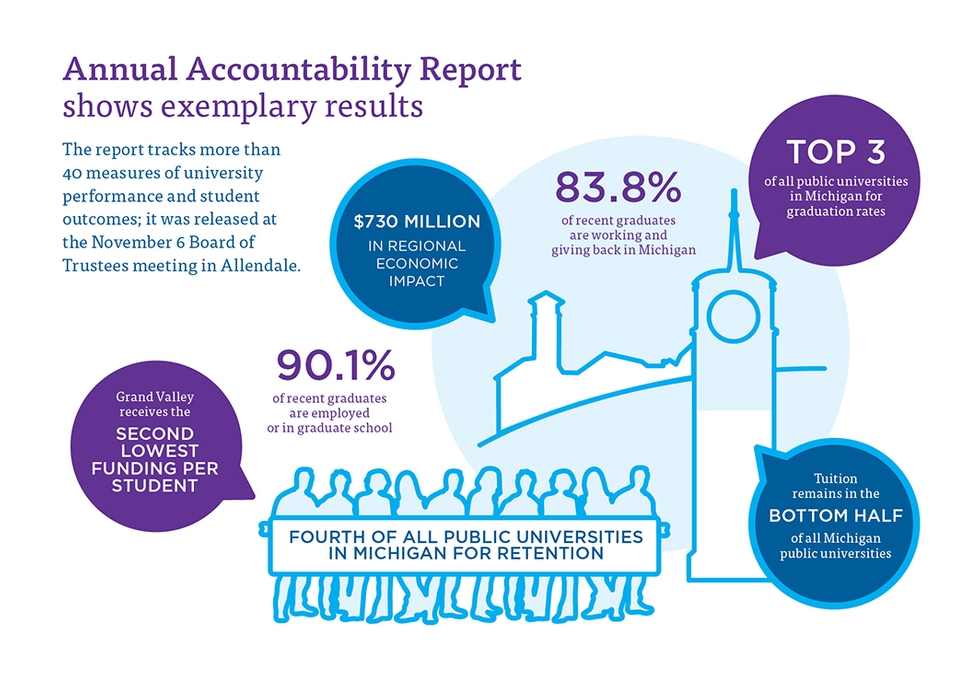Campus News Winter 2016
Laker Effect hails Grand Valley's impact
Grand Valley launched a new branding campaign in February that showcases the collective impact of the “Laker Effect.”
Billboards, print, Web and broadcast advertisements and other materials feature images ranging from students against a background of precipitating university logos to weather map-like satellite images showing Grand Valley’s effect on the region. Rhonda Lubberts, associate vice president for University Marketing, said the umbrella campaign is a play on the meteorological term, “lake effect.”
“Like the lake effect, the Grand Valley community has a broad, profound impact on life in West Michigan, the state and beyond,” Lubberts said. “Lakers are driven by a passion for learning and they use that knowledge, spreading their time, talents and expertise, to make positive contributions across Michigan and elsewhere.”
The research-based campaign used quantitative data that revealed people’s perceptions of Grand Valley. Initial ad concepts were then tested with various audiences that Grand Valley wants to reach.
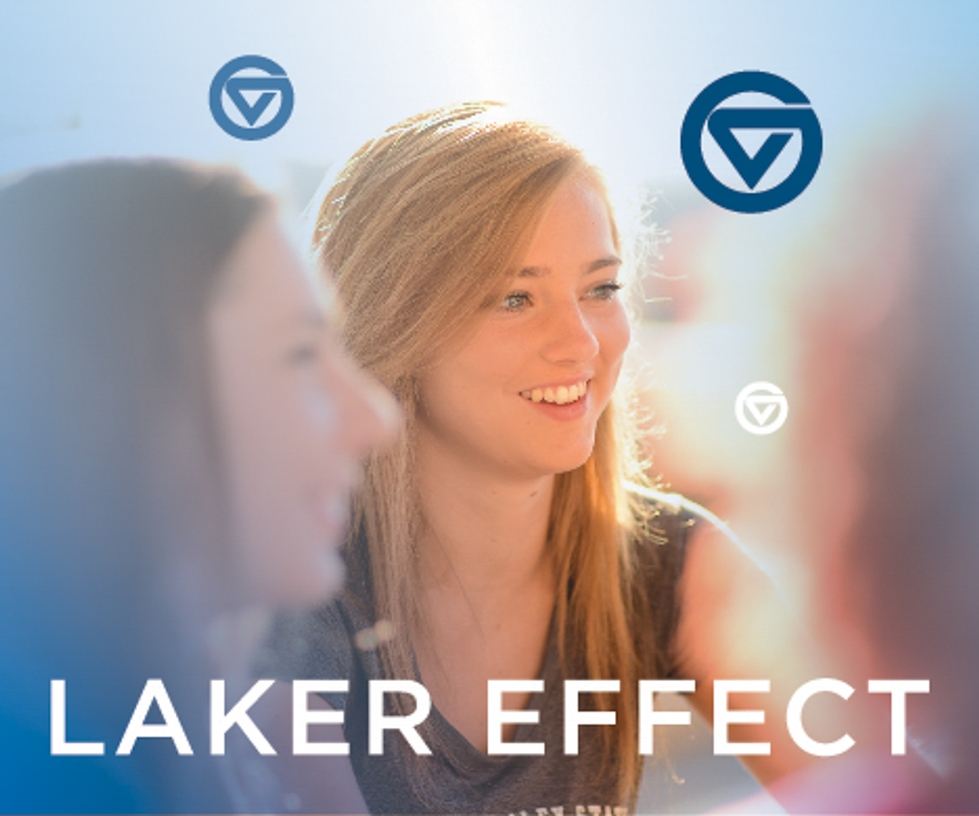
A new image campaign plays off the meteorological term and represents how Lakers look outward and spread their time and talents across Michigan and beyond.
Follow and participate in the campaign on social media using #GVLakerEffect.
See the effect Lakers are having online at gvsu.edu/LakerEffect.
Second endowed professor of civil discourse named
The new Padnos/Sarosik Professor for Civil Discourse will bring his background in international relations and global migration to the position.
Jack Mangala was introduced as the second professor of civil discourse November 19 at a symposium at the Eberhard Center. The endowed professorship is housed in the Brooks College of Interdisciplinary Studies and was given as a gift to Grand Valley in 2013 from longtime university supporters Shelley Padnos and Carol Sarosik.
Mangala is an associate professor of African and African American studies and political science. He plans to develop a course for the fall 2016 semester that focuses on global migration and the challenges and opportunities immigrants and refugees present for host communities.
Mangala said he is interested in the virtues of civil discourse in personal and public spaces, and he sees civil discourse as a critical skill for college students.
“Keeping a tradition of civil discourse, particularly when we confront complex and sensitive issues, is absolutely critical in preserving the essence of a public democratic life,” he said.
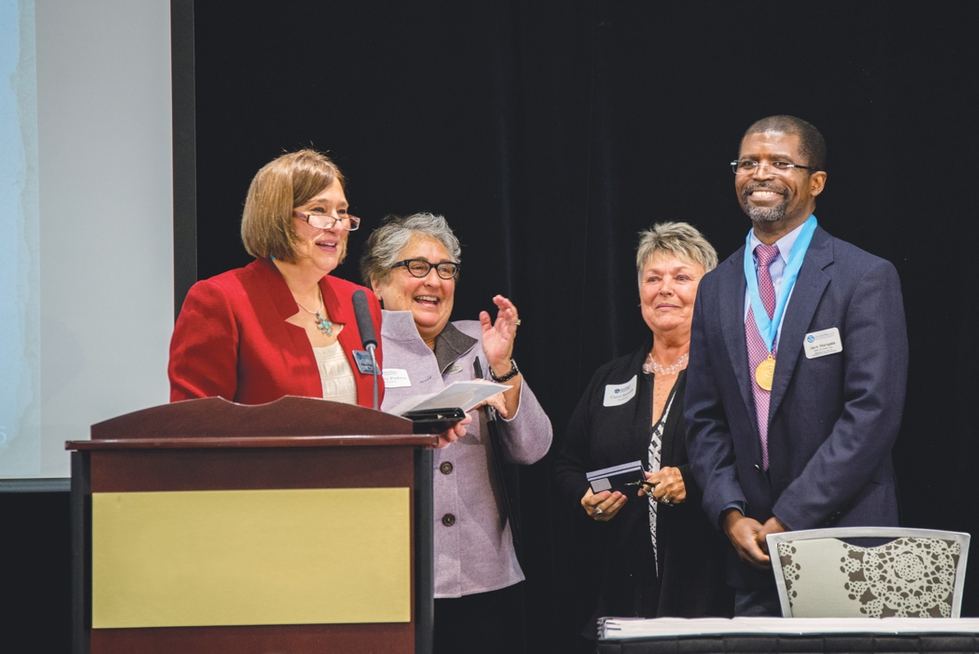
Jack Mangala was named the new Padnos/Sarosik Professor for Civil Discourse; he is pictured at a November symposium with, from left, Anne Hiskes, Shelley Padnos and Carol Sarosik.
He is also charged with planning a community symposium this fall. Mangala said the event’s overarching theme will be to bring together stakeholders involved in immigrant and refugee integration to engage in dialogue and share strategies and experiences on how West Michigan can create welcoming communities for those populations.
Lisa Perhamus, assistant professor of education, served as the inaugural Padnos/Sarosik Professor for Civil Discourse.
Soccer three-peat
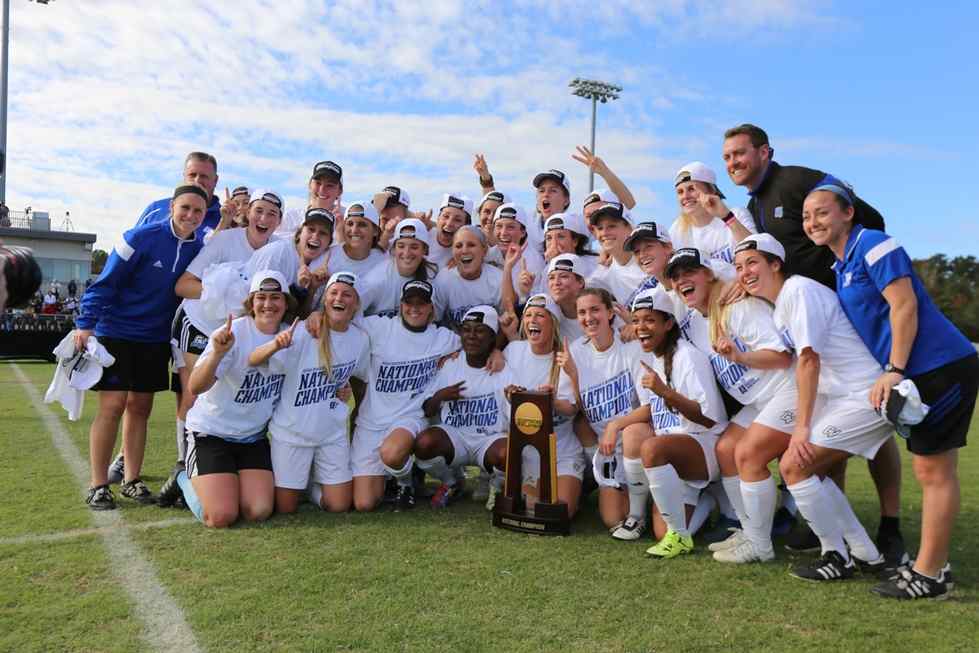
Grand Valley’s soccer team is pictured with the NCAA Division II national championship trophy, following a 2-0 win over Columbus State. It is the team’s third consecutive national title.
photo courtesy of Emily Frye
The Laker soccer team won the NCAA Division II National Championship December 5, beating Columbus State, 2-0, in Pensacola, Florida.
It’s the third consecutive title for Grand Valley, dating to the 2013 season, and the program’s fifth national championship. Goals were scored by junior Marti Corby, who was named to the NSCAA All-American First Team, and senior Katie Bounds.
The Lakers finished the season at 23-1-1, scoring 104 goals and shutting out 17 opponents. It was also the third straight NCAA Championship shutout for the Lakers, having shut out the University of West Florida in 2013 and Rollins College in 2014.
Midfielder Dani Johnson, a sophomore, said the Lakers came in to get the job done.
“That’s what we come to Grand Valley to do, is to get here and win national championships,” said Johnson, from Toledo, Ohio. “I have a lot of teammates to look up to, on and off the field, and one thing that I harp on all the time is our team chemistry to get us through each and every day, the good days and bad days.”
Philanthropist and friend Ralph Hauenstein dies at age 103
Grand Valley joined the West Michigan community in mourning the death of Ralph W. Hauenstein. He died in Grand Rapids January 10. Hauenstein was 103 and two months away from his birthday.
Hauenstein was a major supporter of Grand Valley, including his significant gifts to found, and later expand, the Hauenstein Center for Presidential Studies.
Hauenstein went beyond financial support for the university, sharing both his insights and his time as a member of the Grand Valley University Foundation advisory cabinet. He was often seen with the students in the Cook Leadership Academy in the Hauenstein Center.
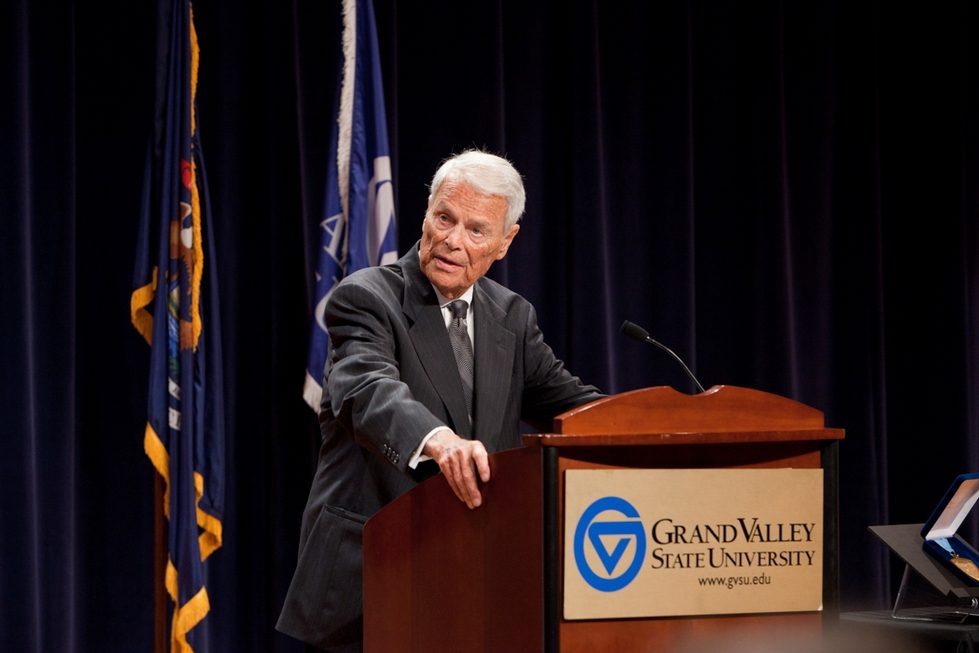
Ralph W. Hauenstein died January 10 at age 103. He founded and later gave gifts to expand the Hauenstein Center for Presidential Studies.
After a career in newspapers in Grand Rapids, he served in intelligence during WWII under General Eisenhower. After a distinguished military career, he became a business leader in the import-export business. Hauenstein went on to become a leading philanthropist in the region.
“Ralph Hauenstein was an extraordinary individual,” said President Thomas J. Haas. “He was a man of great honor, great integrity and all who knew him feel it was a privilege. His presence in our lives and in this community will be sorely missed.”
He received an honorary doctorate from Grand Valley in 2004, and said: “If you are going to be a leader, if you are going to serve your community and your country, then you must not be timid or resigned to come-what-may. You must take the future into your own hands, to the extent that you are able. You must work to turn the odds in your favor. What is needed are courageous, visionary leaders.”
Hauenstein Center accepts $1 million gift
The Hauenstein Center for Presidential Studies in November accepted a $1 million gift from local business leader J.C. Huizenga and his wife, Tammy.
Both J.C. and Tammy Huizenga are directors for the Grand Valley University Foundation; J.C. Huizenga also serves on the Hauenstein Center Executive Board. Tammy is a physician with a clinical practice, the Born Clinic.
The gift will be used to expand the impact the center has regionally and around the nation while working to achieve its mission of preparing a community of ethical, effective leaders for the 21st century.
Annual Accountability Report shows exemplary results
WGVU project explores inclusion, equity
WGVU Public Media has launched a multi-year project using on-air and digital programming, as well as community events, to explore race, inclusion and equity issues throughout its coverage area of west and southwest Michigan.
The project is funded by a $230,000 grant from the W.K. Kellogg Foundation and will use television, radio, digital and social media to gather and share stories in an effort to initiate community conversations.
The grant included funding for an inclusion reporter position and producer for two years to produce content for WGVU Public Media. The project is currently producing stories for WGVU 88.5/95.3 FM along with the website and a new television show, “Mutually Inclusive,” premiered in February on WGVU-TV, hosted by Mariano Avila.
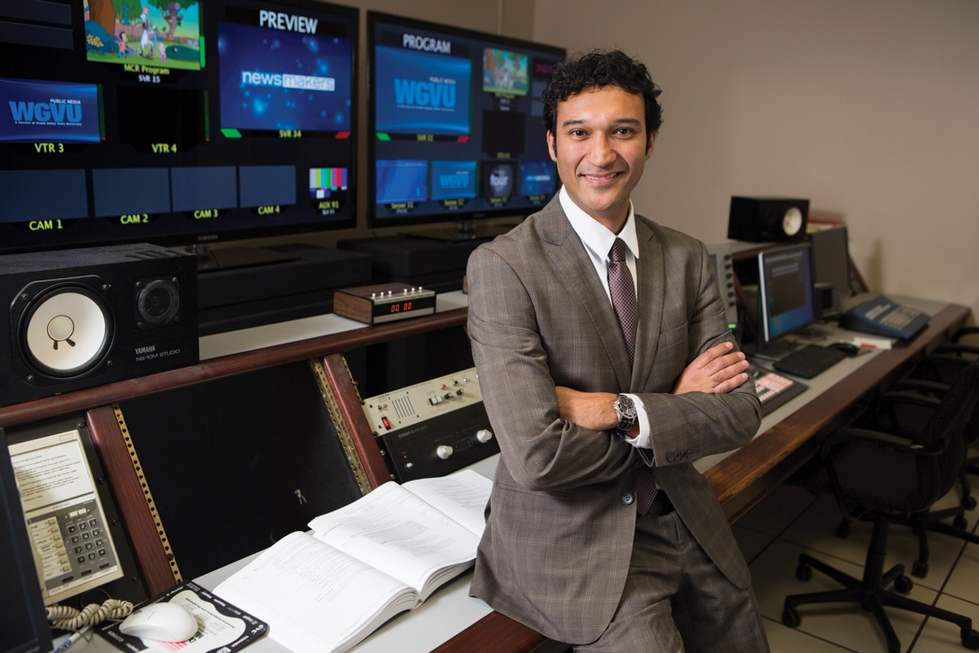
Mariano Avila is the inclusion reporter for WGVU Public Media. His new show, ‘Mutually Inclusive,’ began in February.
photo by Jess Weal
“Focusing on inclusion and equity has always been a priority of WGVU,” said Michael T. Walenta, WGVU Public Media general manager. “Through WGVU Engage, we collaborate with many other area organizations around five key areas — inclusion, health, arts, veterans and education. We are proud to be partnering with the W.K. Kellogg Foundation and our community partners to increase awareness of inclusion and equity issues.”
Avila is a seasoned reporter who brings a passion for social justice issues to the position.
“I will find the voices who are not traditionally represented in media,” Avila said.
For more information visit wgvu.org/.
Studying how to best improve activity for patients with heart failure
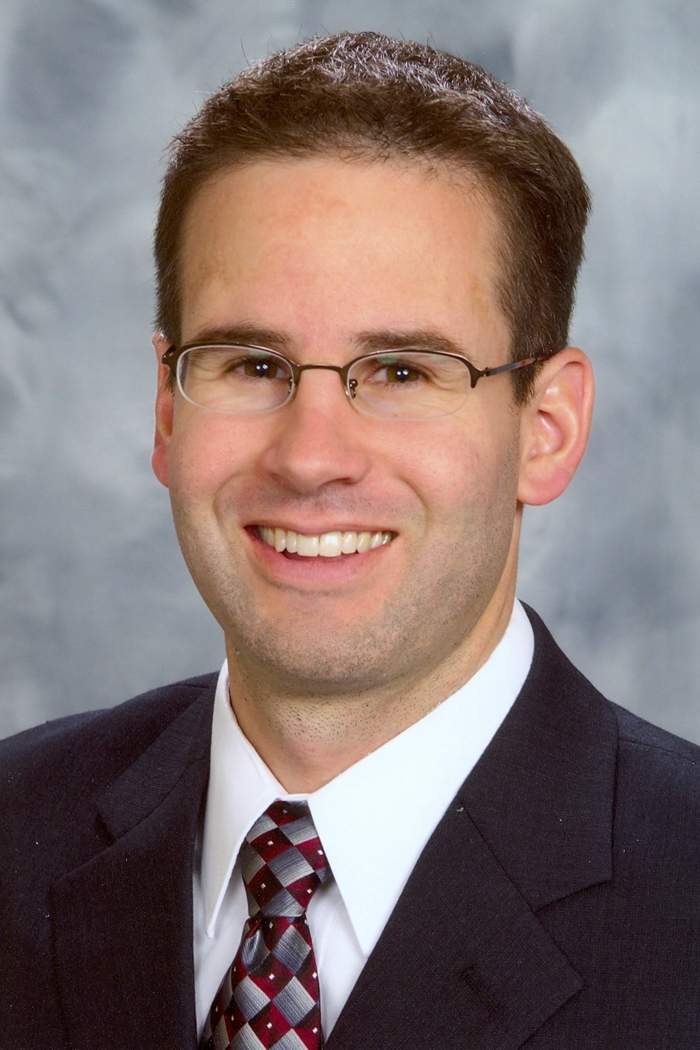
Michael Shoemaker
A physical therapy faculty member is researching promising ways to improve daily activity for individuals with heart failure.
Heart failure is most often a consequence of damage to the heart muscle from heart attacks, viral infections, valve problems, or chemicals like chemotherapy. The goal, said Michael Shoemaker, associate professor of physical therapy, is to improve daily activity — whether it’s concentrated exercise or more daily movement in general — for this growing population of people.
“Asking a patient with heart failure to exercise more often isn’t enough, so this study looks at the effects of consistently working with them to change behaviors and create habits,” said Shoemaker, also a physical therapist for Spectrum Health. “The more active you are, the better you’ll function, and the longer you’ll live.”
The study is led by Shoemaker and Michael Dickinson, medical director for heart failure at Spectrum Health and medical director for the Richard DeVos Heart and Lung Transplant Program. The study includes 33 subjects whose ages range from 41-85 years old. A physical therapist visits with each subject once a week for three months.
The study began in October 2014. It is supported through a $40,000 grant from Medtronic’s Cardiac Rhythm Disease Management External Research Program.
Student begins second NASA internship
Engineering major Amanda Stark aimed for the stars and landed pretty close, earning an internship with NASA in Langley, Virginia.
Stark, who is earning a bachelor’s degree in product design and manufacturing engineering, works with hardware that is bound for space at the System Integration and Test Branch.
Using a vacuum chamber, Stark and her team recreate the harsh conditions of high orbit. “We want to make sure the equipment is going to work on the hot side of the Earth and the cold side,” Stark said. “We run the equipment through the test to make sure it will actually work in Earth’s orbit.”
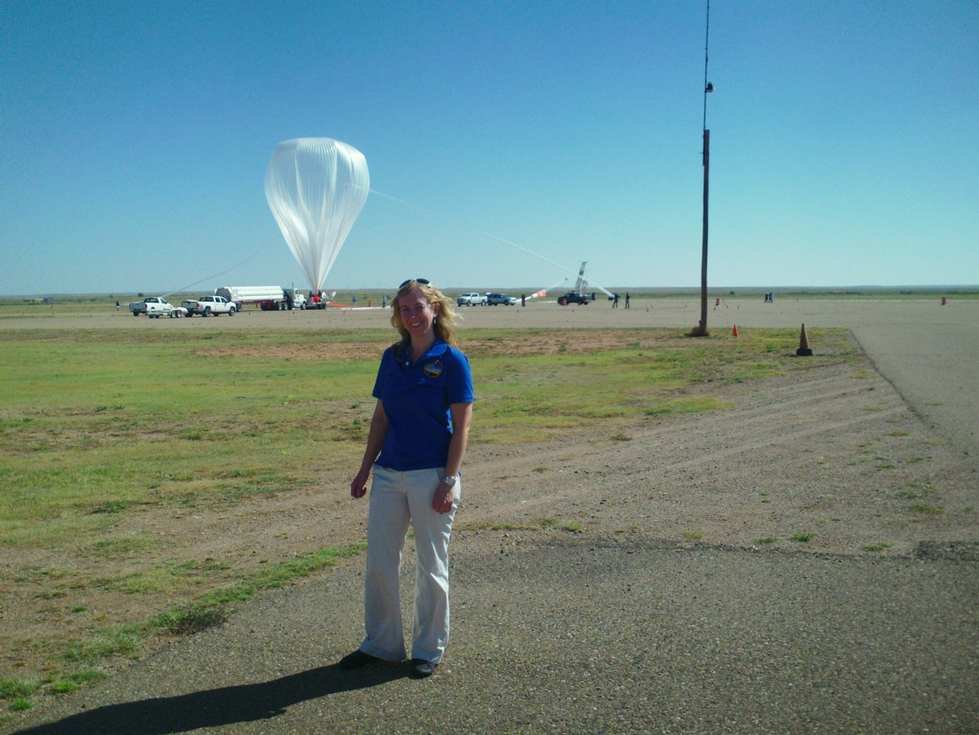
Amanda Stark at the launch of Rad-X in Langley, Virginia.
Stark also worked on a balloon launch project called Rad-X. The purpose of the project is to study the harmfulness of the radiation levels commercial aircraft are exposed to at high altitude. “They asked me to go down and actually work the launch with them, so that was pretty slick,” she said.
Stark said her time with NASA has helped her better understand the concepts she learned in her engineering classes at Grand Valley.
This was Stark’s second semester with NASA. She interned with the space agency in winter 2015 as well. Both times she joined various teams, helping conduct tests and preparing hardware for launch.
Students launch YGR app
A group of Grand Valley seniors developed a mobile app called YGR, or Why Grand Rapids. The app features a host of Grand Rapids-based stores, restaurants, companies and transportation and entertainment options.
The free app also features information in six categories: entertainment, community, jobs, living in GR, networking and government. It is available in the Android Play Store and coming soon to the Apple Store.
The idea for the app came from a partnership between Grand Valley and the City of Grand Rapids established in 2014. Former Grand Rapids Mayor George Heartwell asked Grand Valley students for suggestions on how to attract and keep college graduates in the city. A special course was established in fall 2014 where students conducted research and presented 10 recommendations to Heartwell.
Heartwell immediately implemented two of the recommendations — development of the YGR mobile app and the creation of the Mayor’s Millennial Advisory Board, made up of representatives from area colleges and universities and from young professional organizations. Students who helped develop the app called themselves “Advanced Solutions” and worked under the direction of instructor David Lange in the School of Computing and Information Systems.
Shinsky earns Big Ten humanitarian award
John Shinsky, interim dean of the College of Education, was named the 2015 recipient of the Big Ten Dungy- Thompson Humanitarian Award.
The award recognizes Big Ten players who have achieved success in the area of humanitarianism after college; Shinsky was an All-American football player for Michigan State University. He was a three-year letter winner from 1970-73, earning Academic All-America recognition and second-team All-Big Ten honors in 1973.
As a former orphan, Shinsky has committed his life to serving the needs of abandoned children. He and his wife, Cindy, are co-founders of Ciudad de los Niños, “The City of the Children,” orphanage in Matamoros, Mexico.
“I am humbled to receive this award and consider it a tribute to all of the exceptional people who have supported me and Cindy for the past 10 years with building and operating the orphanage,” Shinsky said.
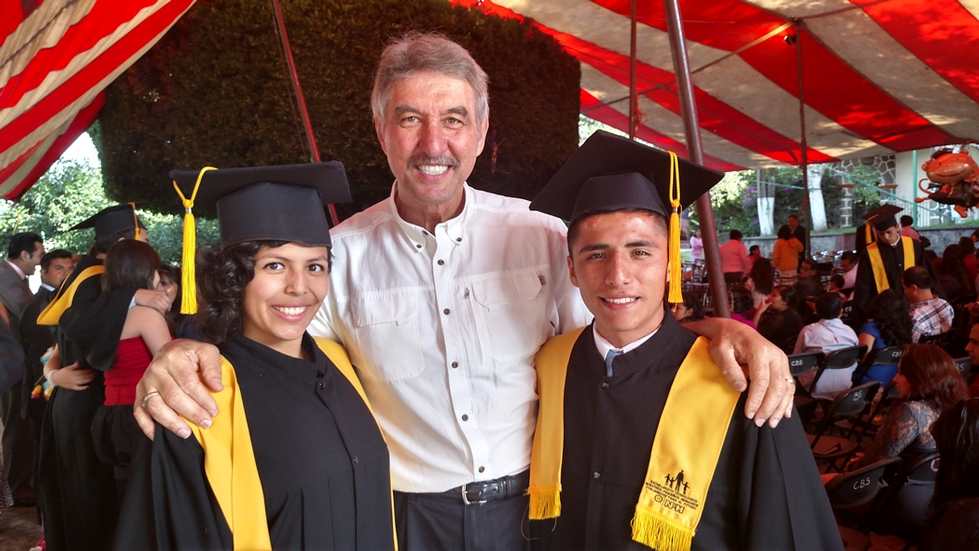
John Shinsky is pictured with two children who live in an orphanage Shinsky and his wife, Cindy, established in Mexico. For his humanitarianism, Shinsky earned an award from the Big Ten Conference.
He also credited the orphanage’s partner organization, Nuestros Pequeños Hermanos, for the day-today work of caring for 100 children.
The Dungy-Thompson Humanitarian Award is named for Minnesota’s Tony Dungy and Indiana’s Anthony Thompson.
For more information about the orphanage, visit shinskyorphanage.org.
Student receives tuition assistance from Make-A-Wish Michigan
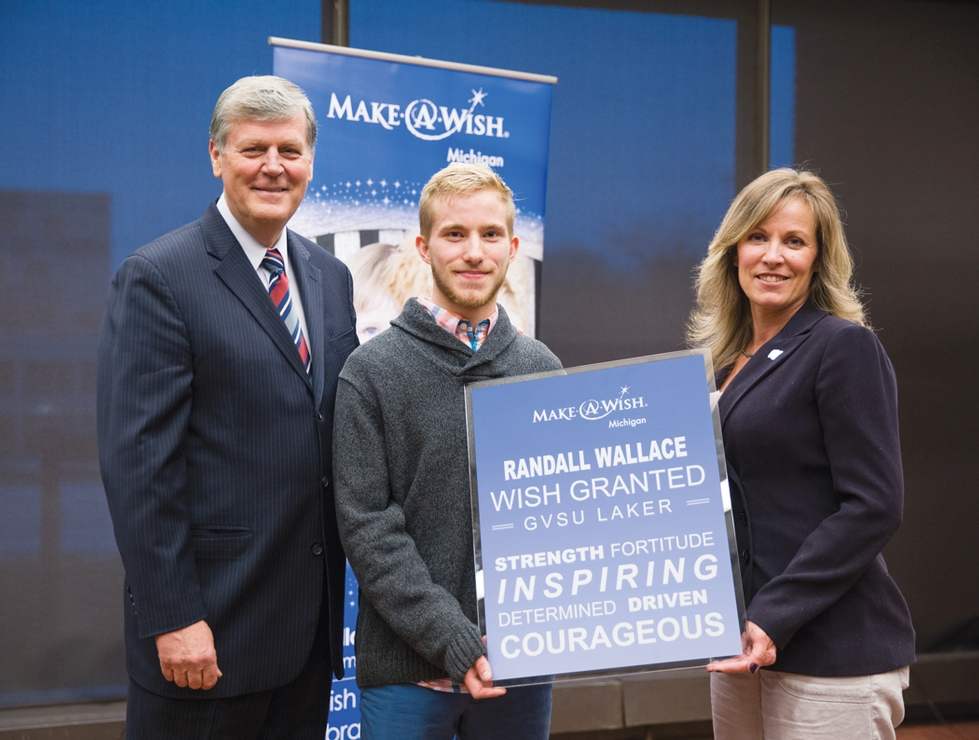
Pictured from left are President Thomas J. Haas, Randall Wallace and Renae Wallace at a February ceremony marking Wallace’s Make-A-Wish: tuition assistance to Grand Valley.
photo by Amanda Pitts
When Grand Valley student Randall Wallace was granted a wish from Make-A-Wish Michigan, he knew exactly what to ask for: tuition assistance to help him pursue his dream of becoming a doctor.
At 5 years old, Wallace was diagnosed with a congenital cardiac condition. Now, at age 18, Wallace hopes to become a pediatric cardiologist in order to help children like himself. He is double-majoring in pre-medical studies and biomedical engineering.
Wallace, a native of Kingsley, was honored at a celebration in the Kirkhof Center February 2. He was joined by President Thomas J. Haas; Jennifer Connery, chief operation officer for Make-A-Wish Michigan; and Donald Malcolm, a pediatric cardiologist at University of Michigan who has treated Wallace since birth.
Malcolm has performed four open-heart surgeries on Wallace. The first one took place when Wallace was 3 weeks old, the second when he was 17. “What makes Randall remarkable is not just that he endured all the surgeries and procedures, but how he faced them. He is calm, optimistic and fearless,” said Malcolm.
Haas agreed with Malcolm. “Randall is an inspiration, and we’re glad that he chose to become part of the Grand Valley family. He is a Laker, which means he will take what he learns here and go out into the world and make a difference,” said Haas.
Wallace completed 56 credits during his senior year of high school before he started his first semester at Grand Valley in fall 2015. He said he is thrilled to be able to start his education at Grand Valley, and hopes to eventually attend medical school at University of Michigan. “It’s only natural, since that’s where all my surgeries took place,” Wallace said.
His mother, Renae Wallace, said her son has been granted the gift of higher education, which he will continue to use for the rest of his life.
“He missed many days of school because of multiple surgeries, but he worked hard and told me when he was 16 that he wanted to become a pediatric cardiologist and help kids like himself,” Renae said.
Heartwell joins sustainability office
Former Grand Rapids Mayor George Heartwell joined Grand Valley’s sustainability team in February.
Heartwell is the community sustainability coordinator, a part-time position, for the Office of Sustainability Practices in the Brooks College of Interdisciplinary Studies. Heartwell’s 12-year tenure as mayor ended December 31.
In his new role, Heartwell will further Grand Valley’s goals in the areas of sustainability and civic engagement, and serve as a resource for students. He will continue to chair the Grand Rapids Community Sustainability Partnership and Grand Rapids Regional Center of Expertise in Education for Sustainable Development.
Heartwell said he is honored to join Grand Valley. “I look forward to bringing to Grand Valley my passion for sustainability, the broad network of relationships I cultivated during my time in public office, and my love of West Michigan,” he said.
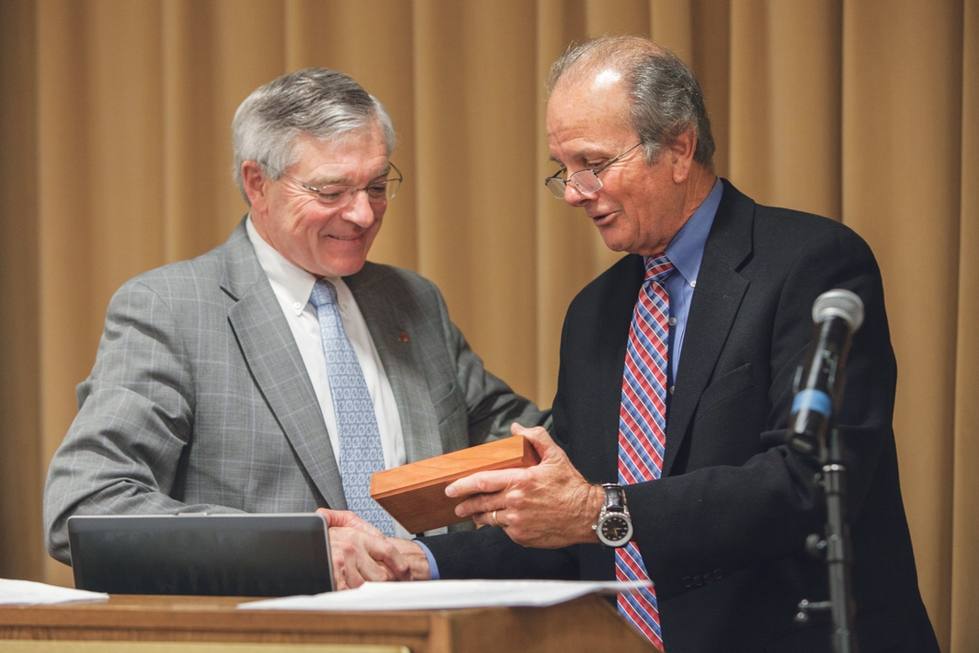
Former Grand Rapids Mayor George Heartwell, left, is pictured at a 2015 Sustainability Champions event with Norman Christopher, executive director of the Office of Sustainability.
Board of Trustees approves agreements for Belknap development
Grand Valley’s Board of Trustees approved two memos of understanding regarding property the university owns in the Belknap neighborhood in the city of Grand Rapids. The approvals came at the board’s February 12 meeting at the L. William Seidman Center, following the city commission’s approval at its meeting earlier that week.
The MOUs followed a collaborative process by representatives from Grand Valley, Neighbors of Belknap Lookout, and the city. The three parties are committed to cooperatively developing the property while keeping the needs of the neighborhood and those who live there in focus.
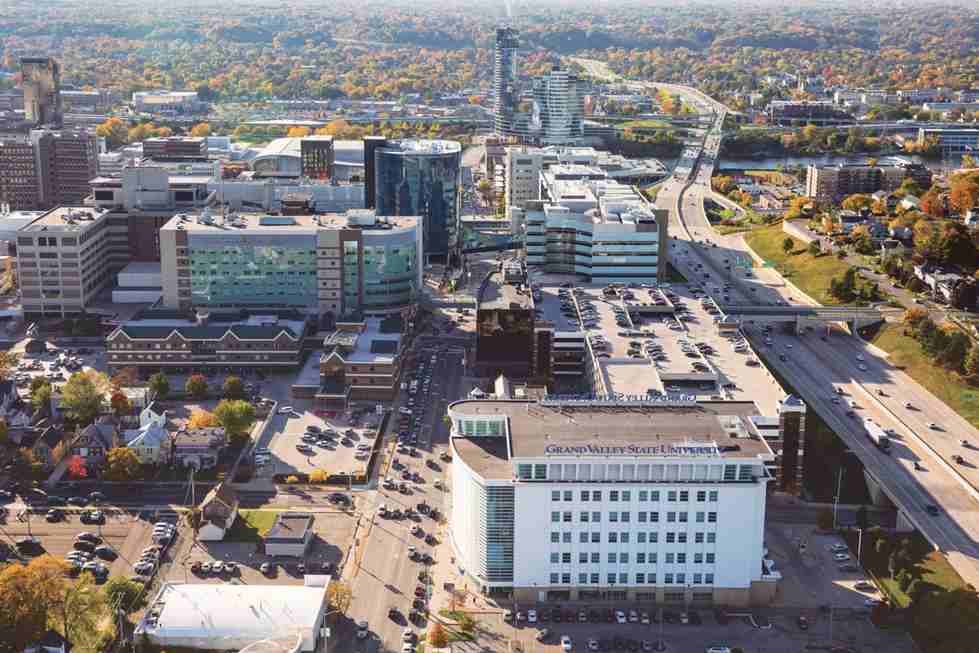
Pictured is an aerial photo showing the Cook-DeVos Center for Health Sciences on Michigan Street. The university will expand its health campus north of I-196.
One agreement involves vacating an alley that is on the university’s property, planning for affordable housing and the review process for building plans when they are developed. The other agreement uses the urban planning consultants SmithGroupJJR and involves how the university will work with the neighborhood to ensure that any future building on university property fits in with the character and integrity of the neighborhood.
“Grand Valley is committed to working with the neighborhood so that future development enhances the area,” said President Thomas J. Haas. “These memos of understanding illustrate our desire to help the city with affordable housing and the area residents with employment opportunities. The city and the neighborhood representatives are working with us and that will lead to the right outcome for all involved.”
Now that the board and the city have approved these agreements, the university will move into the planning stages for a building that will expand Grand Valley’s health campus. There is no timetable for construction at this time. Grand Valley is the region’s number one provider of health care professionals.
In other board action
Students will see a modest increase in room and board rates beginning with the fall 2016 semester. The board voted to increase the rate 1.6 percent. The average cost for living on campus per semester will increase by $32; the cost per semester in a traditional living center will be $2,725. Students can choose from a variety of meal plans. The cost for the 14-meal a week plan per semester will increase $50 and cost $1,475.
This year’s increase in room and board rates at Grand Valley is less than the five-year state average increase of 3 percent at public universities in Michigan. The fall 2015 occupancy rate at Grand Valley was 6,068 students living on campus. More than 7,800 students purchased a meal plan, which means students who don’t live on campus still choose to use campus dining.

